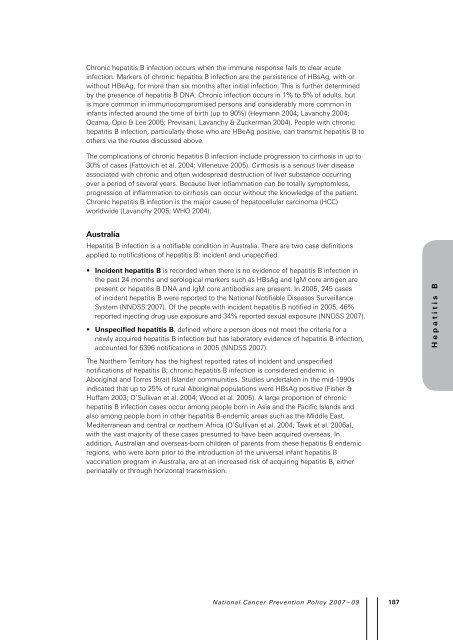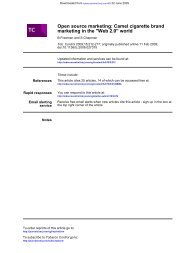National Cancer Prevention Policy - Tobacco Control Supersite
National Cancer Prevention Policy - Tobacco Control Supersite
National Cancer Prevention Policy - Tobacco Control Supersite
You also want an ePaper? Increase the reach of your titles
YUMPU automatically turns print PDFs into web optimized ePapers that Google loves.
Chronic hepatitis B infection occurs when the immune response fails to clear acute<br />
infection. Markers of chronic hepatitis B infection are the persistence of HBsAg, with or<br />
without HBeAg, for more than six months after initial infection. This is further determined<br />
by the presence of hepatitis B DNA. Chronic infection occurs in 1% to 5% of adults, but<br />
is more common in immunocompromised persons and considerably more common in<br />
infants infected around the time of birth (up to 90%) (Heymann 2004; Lavanchy 2004;<br />
Ocama, Opio & Lee 2005; Previsani, Lavanchy & Zuckerman 2004). People with chronic<br />
hepatitis B infection, particularly those who are HBeAg positive, can transmit hepatitis B to<br />
others via the routes discussed above.<br />
The complications of chronic hepatitis B infection include progression to cirrhosis in up to<br />
30% of cases (Fattovich et al. 2004; Villeneuve 2005). Cirrhosis is a serious liver disease<br />
associated with chronic and often widespread destruction of liver substance occurring<br />
over a period of several years. Because liver inflammation can be totally symptomless,<br />
progression of inflammation to cirrhosis can occur without the knowledge of the patient.<br />
Chronic hepatitis B infection is the major cause of hepatocellular carcinoma (HCC)<br />
worldwide (Lavanchy 2005; WHO 2004).<br />
Australia<br />
Hepatitis B infection is a notifiable condition in Australia. There are two case definitions<br />
applied to notifications of hepatitis B: incident and unspecified.<br />
•<br />
•<br />
Incident hepatitis B is recorded when there is no evidence of hepatitis B infection in<br />
the past 24 months and serological markers such as HBsAg and IgM core antigen are<br />
present or hepatitis B DNA and IgM core antibodies are present. In 2005, 245 cases<br />
of incident hepatitis B were reported to the <strong>National</strong> Notifiable Diseases Surveillance<br />
System (NNDSS 2007). Of the people with incident hepatitis B notified in 2005, 46%<br />
reported injecting drug use exposure and 34% reported sexual exposure (NNDSS 2007).<br />
Unspecified hepatitis B, defined where a person does not meet the criteria for a<br />
newly acquired hepatitis B infection but has laboratory evidence of hepatitis B infection,<br />
accounted for 6396 notifications in 2005 (NNDSS 2007).<br />
The Northern Territory has the highest reported rates of incident and unspecified<br />
notifications of hepatitis B; chronic hepatitis B infection is considered endemic in<br />
Aboriginal and Torres Strait Islander communities. Studies undertaken in the mid-1990s<br />
indicated that up to 25% of rural Aboriginal populations were HBsAg positive (Fisher &<br />
Huffam 2003; O’Sullivan et al. 2004; Wood et al. 2005). A large proportion of chronic<br />
hepatitis B infection cases occur among people born in Asia and the Pacific Islands and<br />
also among people born in other hepatitis B-endemic areas such as the Middle East,<br />
Mediterranean and central or northern Africa (O’Sullivan et al. 2004; Tawk et al. 2006a),<br />
with the vast majority of these cases presumed to have been acquired overseas. In<br />
addition, Australian and overseas-born children of parents from these hepatitis B endemic<br />
regions, who were born prior to the introduction of the universal infant hepatitis B<br />
vaccination program in Australia, are at an increased risk of acquiring hepatitis B, either<br />
perinatally or through horizontal transmission.<br />
<strong>National</strong> <strong>Cancer</strong> <strong>Prevention</strong> <strong>Policy</strong> 2007 – 09<br />
1<br />
H e p a t i t i s B




